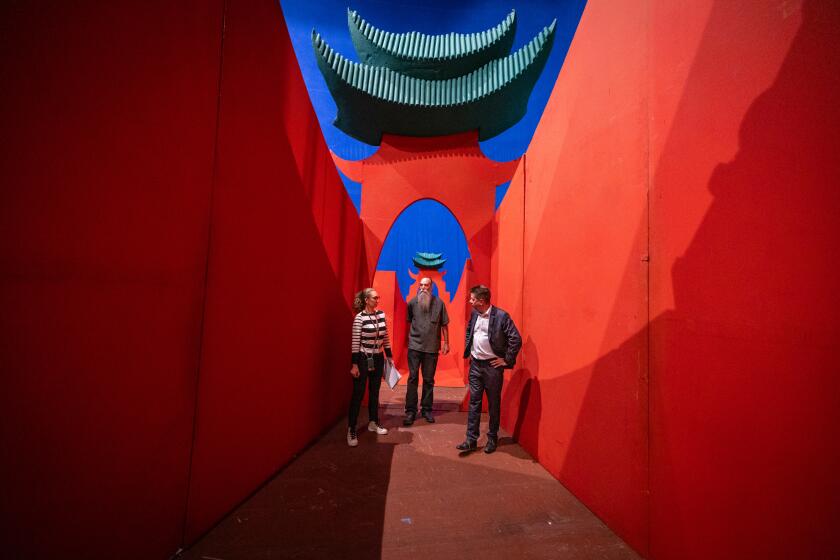The main drag of Valencia is roped...
The main drag of Valencia is roped off. A fresh coat of asphalt has been slapped on and, in a reenactment of a centuries-old tradition from Italy, artists from near and far will spend hours this weekend crouched over squares marked on the street.
Using strongly pigmented chalk sticks called soft pastels, they reproduce large-scale paintings from Renaissance and Baroque masters: bucolic landscapes, darkly majestic images of saints, familiar renditions of ample-bosomed Madonnas.
Most of the artists participating in the Bella Via Italian street painting festival in Valencia won’t be paid. A group of four deemed “featured artists” will each be compensated between $1,000 and $2,500 for the weekend’s work.
Some arrive days in advance to begin sketching and coloring on their oversized works.
For the fourth year in a row, the quiet, decidedly suburban town known chiefly for its proximity to the Six Flags amusement park and CalArts, will turn into a bubbling caldron of artistic activity on Saturday and Sunday.
For the artists, the experience is similar to running a marathon, especially on a hot weekend. “You really have to push through and push past that point where you want to quit,” says local artist Julie Kirk, who’s been involved in all previous editions of the Bella Via festival and this year plans to re-create Caravaggio’s “Christ in the Garden” in a square that measures 10 by 13 feet.
In all of this, it is the festival-goers who get the sweet end of the deal. They typically stroll about at a leisurely pace and merely observe the artists struggle with the physical demands of the work. In that regard, the event is not only pleasant but educational. It drives home the realization that this kind of art--figurative, monumental in scale, painstakingly detailed--extracts a toll of blood, sweat and tears.
Remember Charlton Heston’s Michelangelo in “The Agony and the Ecstasy,” sandwiched in a horizontal position under the ceiling of the Sistine Chapel and laboring over one of his Sybils as paint dripped into his eyes? Well, drawing large reproductions of European masterworks in chalk on hot asphalt for three to four days in a row is no slapdash feat either. The single largest project featured this year will measure 15 by 20 feet; that’s 300 square feet of ground to cover.
“There is this image of artists being flaky and not working hard,” Kirk says. But once the process is seen firsthand, “a lot of people have a new respect for it.”
And maybe a new appreciation for works that otherwise remain confined to the pages of coffee-table volumes or the walls of museum exhibits.
“Many people who come to Bella Via have never been to the Sistine Chapel,” says festival co-director Carol Maglione, who has organized and coordinated the event since 1999. “They have never seen a Caravaggio.”
To them, the festival provides a crash course in Renaissance art and its substantial rewards: the rich detail in the folds of a garment draped across a stretched arm, the infinite nuances of light and shadow, the facial expressions that are both exquisitely human and divinely larger-than-life.
There are simpler pleasures too. An entire block is set aside so children (and adults, if they like) can doodle to their hearts’ content. (Two-foot-by-two-foot squares in this so-called Michelangelo Gallery rent for $10, and the proceeds go to the Bella Via Fund, which raises money for arts projects in Santa Clarita Valley schools.) The free entertainment options range from face painting to cartooning--watch professional animators draw the Powerpuff Girls for you--to two stages of opera singing.
Once dusk descends on the first day of the festival, about two dozen local restaurateurs wheel out samples of their choice eats in a gourmet affair dubbed Slice of Valencia. Among the participants is Cafe Melisse, the snazzy California French bistro that is the Valencia cousin of Santa Monica’s Melisse. It’s planning to unload a selection of pizzas--one topped with chicken bits, smoked gouda and veggies, another a simple margherita with oven-dried tomatoes and roasted garlic.
Street painting originated in 16th century Italy, when entertainment was scant and much excitement would greet itinerant artists called madonnari, who stopped in town squares to draw reproductions of Madonna paintings on the ground. Spectators gathered to watch them work and occasionally threw coins on their drawings. At the end of the day, the artists would pack up and leave for the next town, and the chalk paintings would remain behind until the next rain, or the scuffle of feet, erased them. (After the festival wraps up on Sunday, the chalk drawings are typically erased by Tuesday morning so the street can reopen to traffic. Says director Maglione, “It would be heart-breaking to drive over them.”)
There are about five similar events statewide and a dozen across the nation. Bella Via came about when Newhall Land, a real estate developer from Valencia, sought to generate some ka-boom for the opening of a new mall in 1999. Since then, the number of participating artists and spectators has steadily increased. This year, about 150 chalk painters are expected to trickle in from California and beyond.
There is something powerful about the symbolism of creating a transitory work of art, street painter Kirk says. “It’s one of the things that street artists who do this regularly really enjoy about it: the fact that it is a temporary thing. With most of us, it really is about the act of creating something, rather than a material end. We think of it as performance art.”
*
Bella Via: Valencia Italian Street Painting Festival, Saturday and Sunday,Town Center Drive, Valencia. For information: www.bellaviafest.com.
More to Read
The biggest entertainment stories
Get our big stories about Hollywood, film, television, music, arts, culture and more right in your inbox as soon as they publish.
You may occasionally receive promotional content from the Los Angeles Times.






